Genomics enhancing native plant restoration and conservation
Making the finalists in this year’s Eureka Prizes, a project led by Botanic Gardens of Sydney scientists is exploring the DNA of tens of thousands of plants to ensure the survival of more than 120 Australian plant species.
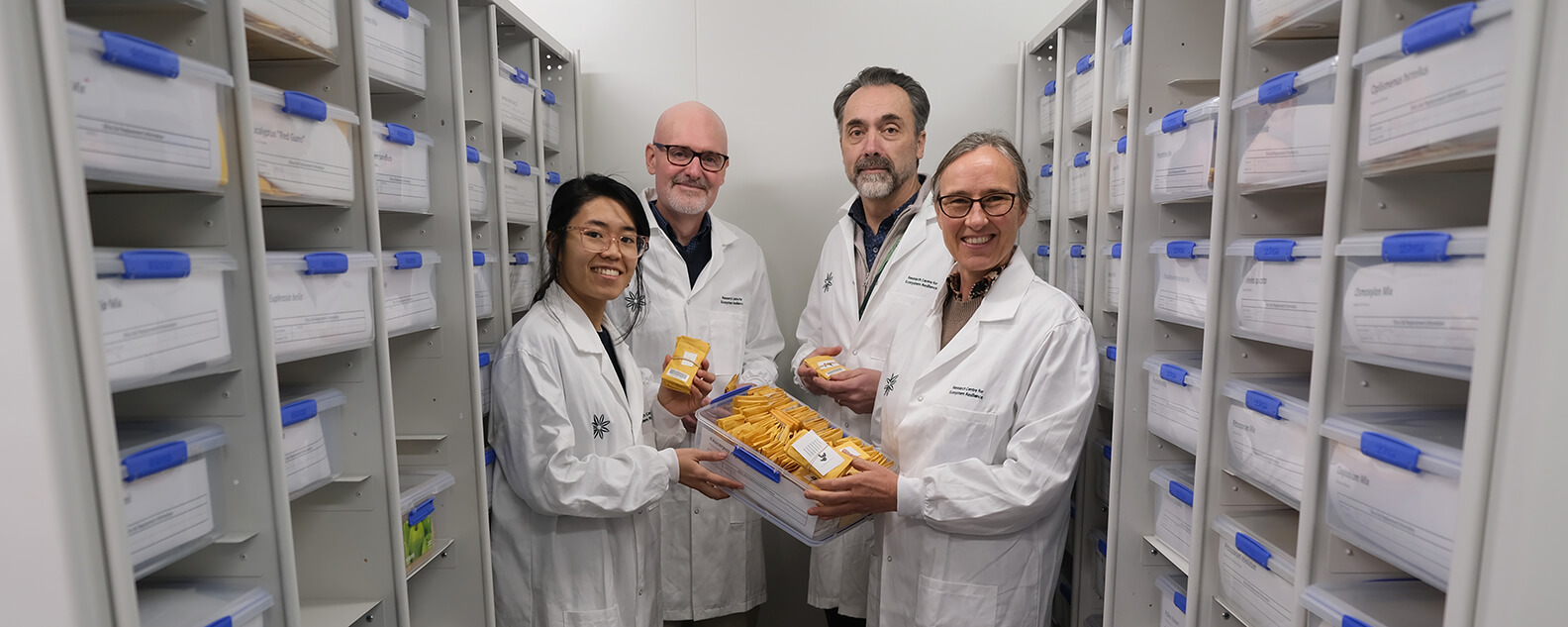
In 2019, the Research Centre for Ecosystem Resilience (ReCER) at Botanic Gardens of Sydney published ground-breaking research on how to gather and interpret vast amounts of genomic data to help ecological restoration.
Since launching, the team has collected leaf samples from more than 89,000 plants and an ever-growing database is supporting the restoration and conservation of more than 130 Australian plant species.
The world’s first free genomics tool for practitioners
The ability to collect and sequence the DNA of tens of thousands of plant samples is not the only ground-breaking aspect of the Restore and Renew Knowledge Infrastructure project. What makes this ambitious project most unique is that it is the first tool globally to make genomic guidance freely available for restoration practitioners, community groups and others who are restoring native vegetation.
Restoring Big Scrub
The restoration of critically endangered lowland rainforest by the Big Scrub Rainforest Conservancy is guided by genomic information.
The ‘Big Scrub’ was once the largest area of lowland subtropical rainforest in Australia; it covered 75,000 hectares in the hinterland of Byron Bay in northern New South Wales, until cleared for farming. Today, less than 1% remains.
There’s so little rainforest left that sourcing genetically diverse seed to use in restoration is a challenge.
“We are using genomic information to restore genetic diversity lost through clearing and fragmentation of native vegetation,” says Professor Maurizio Rossetto, Head of Research Centre for Ecosystem Resilience.
“By understanding how genetic diversity is distributed across the landscape, we can source seed from multiple populations and restore gene flow that was disrupted by habitat loss, creating renewed populations that are better equipped to survive in a changing environment.”
Professor Maurizio Rossetto, Head of Research Centre for Ecosystem Resilience
The Science Saving Rainforests program, a collaboration between ReCER and the Big Scrub Rainforest Conservancy, is using genomic information to design a multi-species living seed bank plantation that will produce genetically diverse planting stock for restoration plantings. Genomic research is underway for 60 species and involves DNA sequencing of more than 10,000 leaf samples.
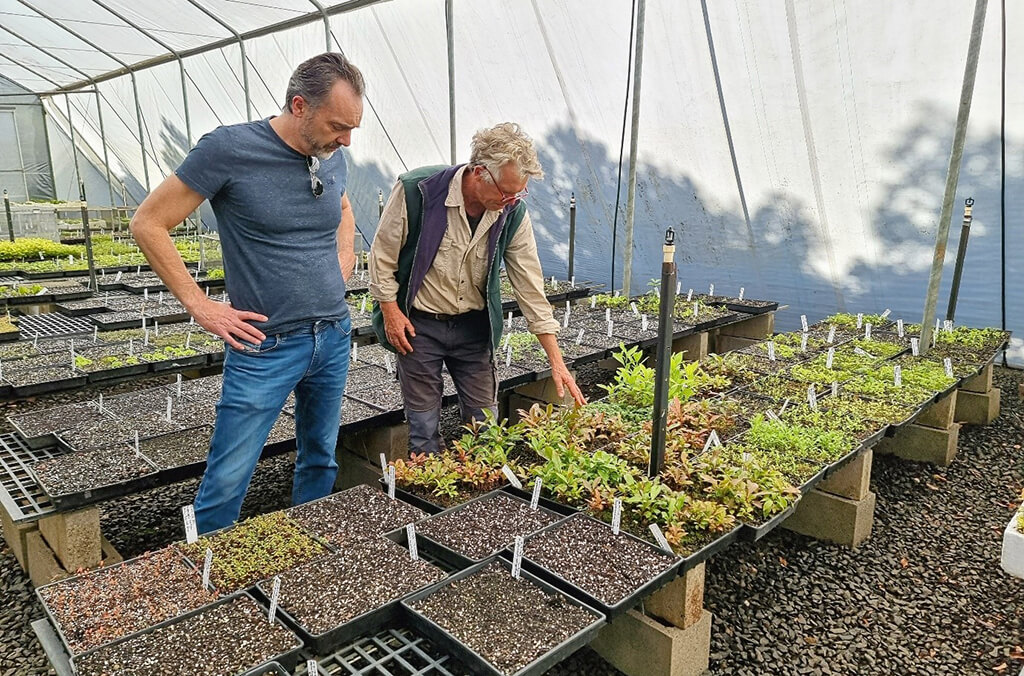
Professor Maurizio Rossetto and Mark Dunphy, President of the Big Scrub Rainforest Conservancy, inspecting plants being propagated for an optimised seed orchard.
“Our Science Saving Rainforest program is, to our knowledge, the largest ever to apply genomic information to restoration and conservation of a critically endangered ecosystem,” says Tony Parkes, President Emeritus of the Big Scrub Rainforest Conservancy.
"These innovative genetics-based methods will improve restoration of critically endangered lowland rainforest and its many threatened plant species."
“The threat of extinction arises principally from the lack of genetic diversity in the very small populations of many key structural and threatened species in the fragmented, isolated remnants of this largely cleared ecosystem,” says Parkes.
“An additional threat emerges from the lack of genetic diversity in the extensive restoration plantings of more than 2.5 million trees frequently propagated from seed collected from a small number of easily accessible trees.”
Tony Parkes, President Emeritus of the Big Scrub Rainforest Conservancy
"The genetically optimised planting stock will re-introduce genetic diversity lost through generations of clearing and help to build populations of trees that can survive well into the future,” says Parkes.
Genetic rescue of Coastal Fontainea
While the Restore and Restore project was developed specifically for restoration, the methodology is also being applied to other areas, including threatened species conservation.
The critically endangered Coastal Fontainea (Fontainea oraria) dwindled down to only ten trees. It grows in rainforest at Lennox Head on the north coast of New South Wales, a region where large-scale clearing has reduced rainforest to a fraction (less than 1%) of its original distribution.
Habitat loss and fragmentation reduced genetic diversity in Coastal Fontainea, and inbreeding was further eroding diversity.
Genetic information has guided the design of new populations, with cuttings taken from the remaining ten trees planted in a circular design to maximise crossbreeding opportunities and to facilitate new genetic combinations.
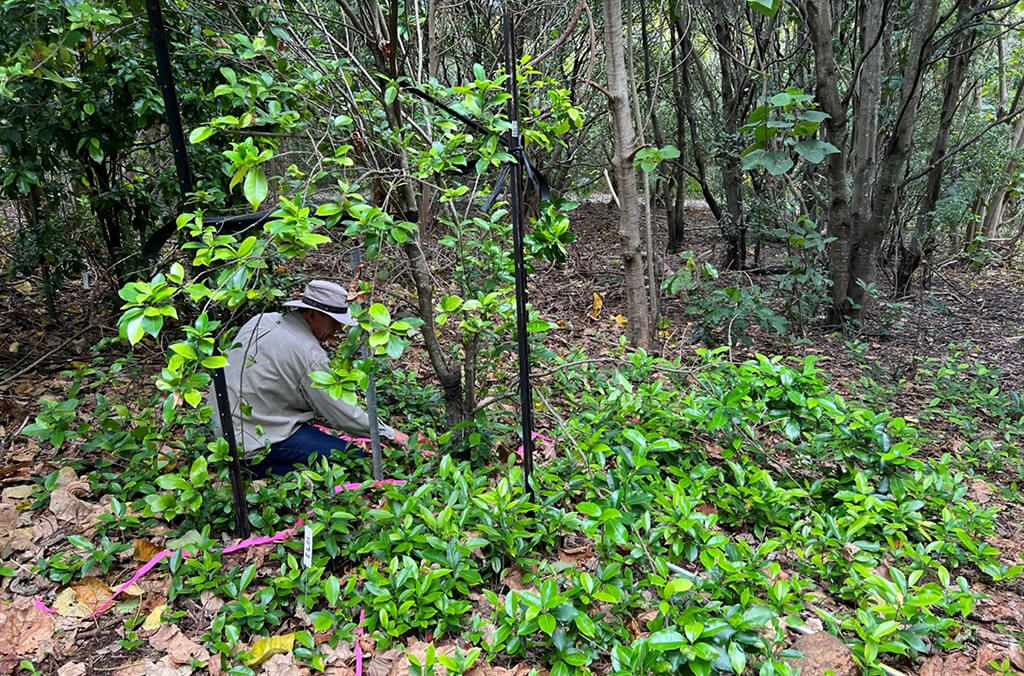
Coastal Fontainea seedlings, each more genetically diverse than the planted tree they are growing under, thanks to a genetically optimised planting design that increased opportunities for crossbreeding. Photo credit: Di Brown.
Further genetic research revealed that the newly established populations captured and recombined the little diversity that remained in wild individuals, with seedlings being more genetically diverse than their parents and all ten individuals contributing to offspring (in comparison to the wild population where only three adults contributed to seedlings).
“The genetic rescue of Fontainea oraria demonstrates how we can overcome the loss of genetic diversity and inbreeding that happens when habitat is fragmentated into small and isolated remnants,” Di Brown, Saving our Species.
“We've taken a threatened species with a decreasing gene pool and used simple genomic information to effectively turn the situation around and secure this species' future,” says Brown.
“We’ve reinstated geneflow that was disrupted by habitat loss and gone from only ten trees that had little opportunity to cross pollinate in the wild, to more than 6,000 plants, all likely to have unique DNA. Most seedlings are the result of crosses between unrelated adults, whereas only one tree parented most seedings in the wild population.”
Di Brown from Saving our Species
Causes and consequence of low genetic diversity
The key reason genetic information is so useful for restoration practitioners and conservation managers is that low genetic diversity decreases the survival of natural and restored populations of plants.
Genetic information helps restoration practitioners and conservation managers restore lost genetic diversity and facilitate gene flow in fragmented landscapes.
Habitat loss and fragmentation reduces genetic diversity in natural populations of plants and sourcing seed from too few plants or from a small geographic area can amplify the loss of genetic diversity in restoration plantings. For example, Coastal Fontainea lost genetic diversity through habitat loss and fragmentation and the loss of genetic diversity in the Big Scrub was amplified by the planting of 2.5 million trees that were often propagated from seed sourced from a small number of trees.
There are many reasons why remnant and restored populations of native plants with low genetic diversity are less likely to survive in the long-term.
Populations with low genetic diversity may not produce viable seed or may produce offspring that are less fit. For example, the threatened plants Astrotricha crassifolia, Haloragodendron lucasii, and Zieria covenyi have so little genetic diversity that natural populations produce no or few seed.
Seed produced by populations with low genetic diversity may also be hybrid rather than pure. For example, eucalypts tend to hybridise with other species when population size is too small or planted individuals are too closely related.
Low genetic diversity creates low adaptive potential, which means populations are less likely to have the genetic attributes that enable them to cope with diseases or adapt to a changing climate.
Freely sharing genomic information
The Saving our Species and Science Saving Rainforest programs are big projects, but it is equally important the thousands of smaller Landcare groups and other organisations undertaking ecological restoration can access genomic guidance.
Given extensive habitat destruction and degradation, and a rapid rate of extinction, the UN Decade on Ecosystem Restoration declares there has never been a more urgent need to revive damaged ecosystems than now. It is important that every little patch of restoration contributes to the long-term health of native vegetation. And they can.
Genetic and climatic guidance not typically accessible to restoration practitioners is freely shared within the Restore and Renew webtools. Restoration practitioners can use this guidance to ensure that restored populations are self-sustaining, able to adapt to change and have maximum evolutionary potential.
Genetically informed seed sourcing guidelines are publicly available through the Restore and Renew webtool for 84 species so far and additional species are added each month.
The Restore and Renew Webtool makes genomic guidance freely available to restoration practitioners and community groups.
To give one example of the relevance and application of the Restore and Renew webtools, restoration of koala habitat is a key target in helping to secure the long-term survival of koalas in the wild, especially in the face of a rapidly changing climate. Leaf samples have been collected for DNA sequencing from almost 10,000 eucalypt trees and seed sourcing guidelines are publicly available within the webtool for 19 eucalypt taxa so far.
These seed sourcing guidelines can help koala feed tree restoration practitioners across eastern Australia ensure their restoration plantings are sufficiently genetically diverse to establish resilient and self-sustaining populations that will survive in the long-term. Without this guidance, practitioners are limited to unreliable generalisations that may underestimate appropriate seed collection areas and lead to restored populations with low genetic diversity, reduced fitness and low adaptability.
Helping small community groups achieve big things
The Restore and Renew webtool enables anyone to freely access genomic guidance that would otherwise cost tens of thousands of dollars.
For exmaple, the small volunteer-run Broke Bulga Landcare group are using these guidelines to enhance the resilience and climate-readiness of their River Red Gum restoration project along Wollombi Brook in the Hunter Valley.

Broke Bulga Landcare are using the Restore and Renew webtool to freely access genomic guidance that is helping ensure the long-term success of their River Red Gum restoration project.
For the first stage of plantings, Broke Bulga Landcare followed best-practice guidelines and sourced ‘local provenance’ seed. In the absence of genomic guidance, they collected seed only from Wollombi Brook, a tributary of the Hunter River.
Research by ReCER revealed the actual genetic neighbourhood for River Red Gums, an area within which geneflow does (or did) naturally occur, is considerably larger and that the Landcare group can safely increase genetic diversity of their plantings by incorporating material sourced from further north. Due to changes in climate, the Hunter Valley is expected to experience conditions in the future that are currently experienced in the Namoi catchment. By sourcing seed from Namoi catchment, the group hopes to increase the climate-readiness of their plantings.
Restore and Renew Knowledge Infrastructure
The scale of Restore and Renew is unprecedented in restoration and conservation genomic research. So far, leaf samples have been collected from more than 89,000 plants across eastern Australia from over 2,000 plant species, with DNA sequencing of 54,000 plants finished. These numbers grow every single month. A ‘knowledge infrastructure’ ensures the collection, management, sequencing and analysis of a vast number of samples is easily managed. It’s effectively a standardised workflow supported by data management tools.
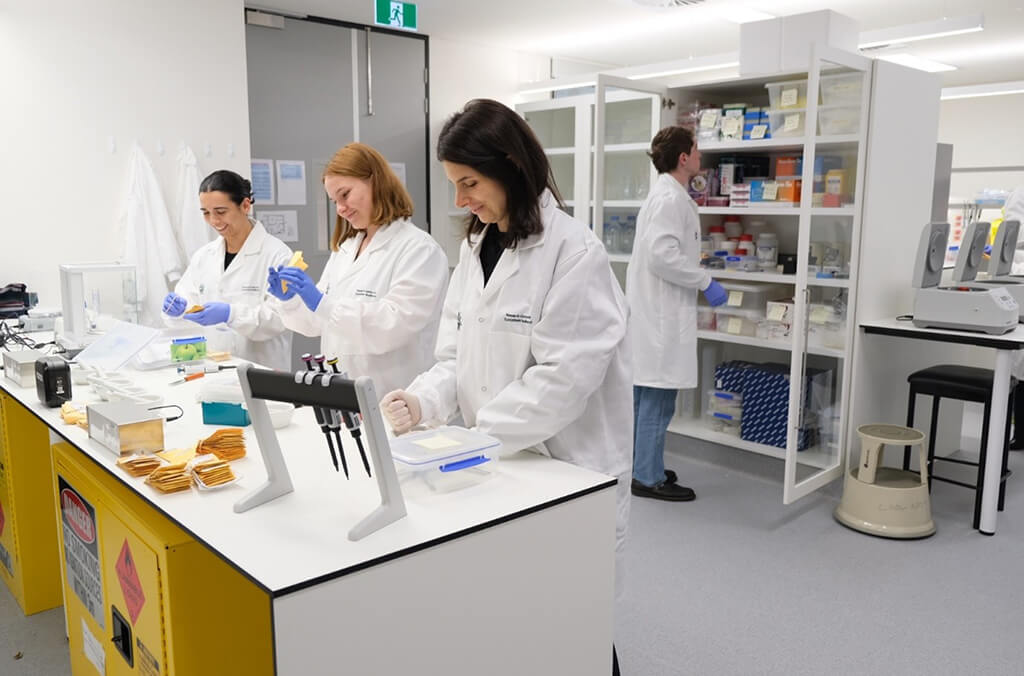
The Research Centre for Ecosystem Resilience recently moved into a new laboratory, established with support from the Foundation & Friends of the Botanic Gardens of Sydney.
The foundation publication ‘Restore and Renew: a genomics-era framework for species provenance delimitation’, described how to gather and interpret vast amounts of genomic data in support of ecological restoration and shared a replicable standardised workflow that makes working on hundreds of species at once feasible.
The initial foundation has been built upon with the support of data management tools. A unique barcode keeps track of each leaf sample as it goes through a process of DNA extraction, sequencing, and analysis.
A purpose-built collections app (ReCER Field Collection App) facilitates easy and rigorous collection of leaf samples, herbarium vouchers and information about the source plant including location and population size. A purpose-built database (Restore & Renew sample management) manages the data, and standardised analysis workflows are refined and updated as analysis methods improve.
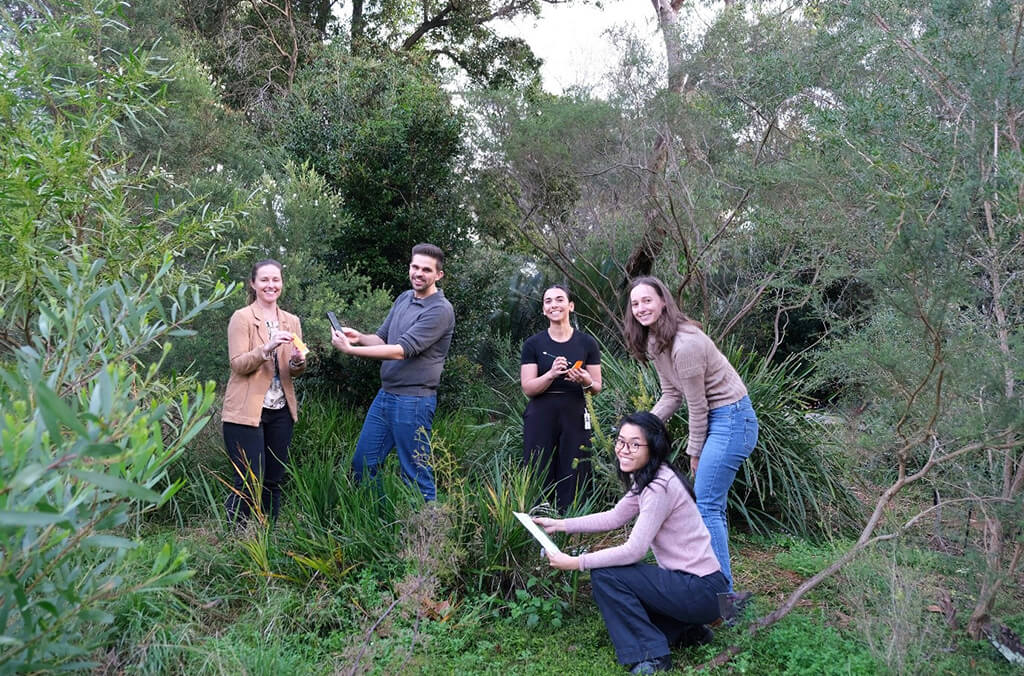
ReCER researchers collecting leaf samples using the ReCER Field Collection App.
One dataset with multiple on-ground applications
A single dataset houses an unlimited number of samples and species and can address an unlimited number of questions now and into the future.
In addition to developing genetically informed seed sourcing guidelines and guiding threatened flora recovery actions, the Restore and Renew Knowledge Infrastructure dataset is currently being used to facilitate biocultural restoration and design living insurance collections for species susceptible to myrtle rust, a disease threatening the survival of at least 350 plant species across Australia.
“The single dataset can be updated as approaches change, meaning that samples collected today, could be answering questions we don’t yet anticipate, a decade from now.”
Prof. Maurizio Rossetto, Head of Research Centre for Ecosystem Resilience
The Restore and Renew workflow concept and process can be replicated across any scale in any country and has the potential to help practitioners across the globe consider genetic information when sourcing material for restoration or designing on-ground recovery of threatened flora.
Excellence in Botanical Science recognised
The Restore & Renew Knowledge Infrastructure Team (Maurizio Rossetto, Marlien van der Merwe, Jason Bragg, Samantha Yapp, and Peter D. Wilson) have been selected as a finalist for the Australian Institute of Botanical Science Eureka Prize for Excellence in Botanical Science.
Visit the Australian Museum to view other finalists.